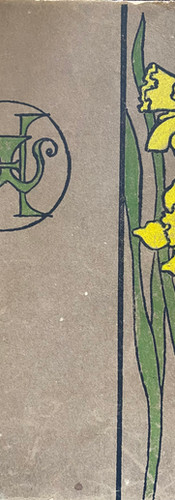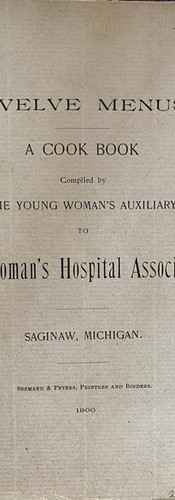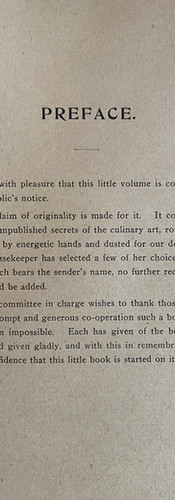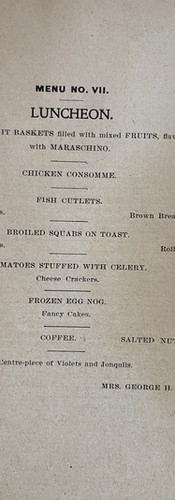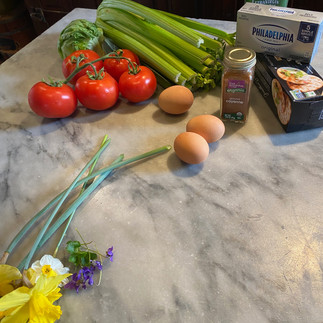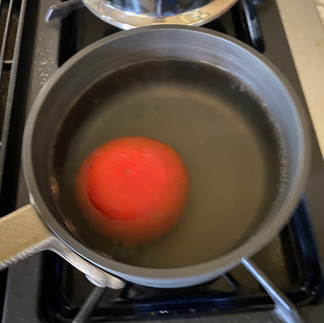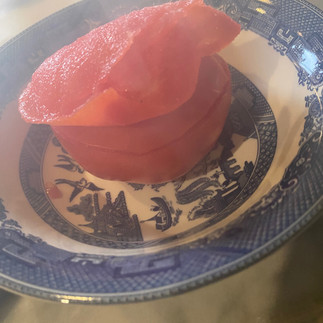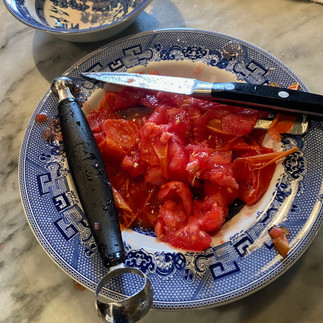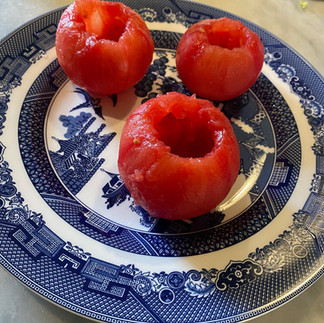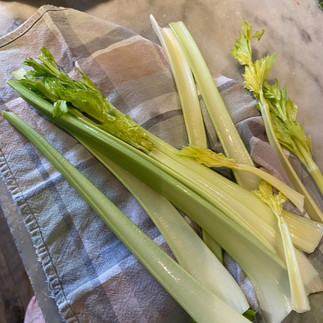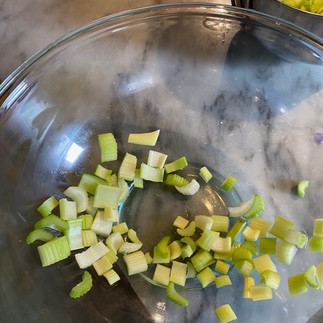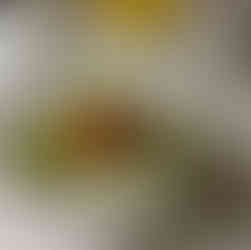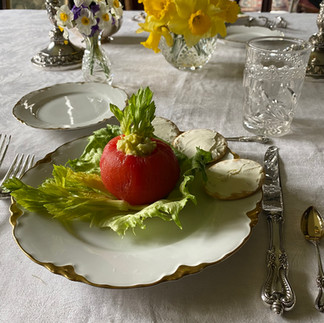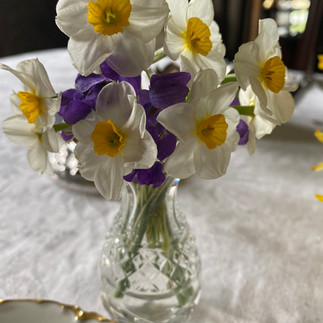Today’s recipe is the fifth course in a seven-course luncheon menu featured in Twelve Menus: A Cook Book published by The Young Woman’s Auxiliary to The Woman’s Hospital Association in 1900. We will explore the history of the Twelve Menus in a future post. Sometime in the future, the test kitchen may attempt to recreate one of the proposed meals. However, that may need to wait until we find an experienced cook and waitress.
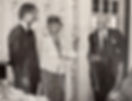
Mrs. George H. Boyd:
Member of Pioneer Family : Mrs. Boyd, Civic Leader, Dies
Mrs. George H. Boyd, 90, for most of her adult life a civic and social leader here as member of one of Saginaw’s pioneer families, died yesterday afternoon at her home, 1617 S. Washington.
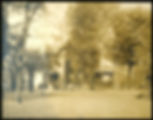
Born her May 29, 1871, she was a daughter of Mr. and Mrs. George Walter Morley. Her husband, the late George H. Boyd, was one of Saginaw’s foremost citizens of his era. He had a long record of community achievement in both municipal and civic betterment affairs.
Like her husband, with whom she shared a love for her home town of Saginaw, Mrs. Boyd devoted many years to community improvement work. She was a devoted worker in the cause of better government, as espoused by the Saginaw County League of Women Voters. Her work in the organization was recognized many times by fellow members. They named her an honorary president.
Long active in affairs of Saginaw Branch, Woman’s National Farm and Garden Association, she had been its president. The staid old Boyd home’s spacious yard in the Grove, across from Hoyt Park, was a verdant showplace. It attested her love for gardening. She was a member of the state board of Federated Garden Clubs of Michigan.
Mrs. Boyd worked diligently in the interests of community culture and development of the Saginaw Museum, She devoted much of her time to helping in supervision of the Children’s Home here. She was a member of its Board of Trustees. She also was enthusiastic worker for betterment of Saginaw General Hospital.
She was member of St. Paul’s Episcopal Church.
Mrs. Boyd, whose maiden name was Letitia Morley, was born her May 29, 1871. She attended Hohe High School in Leipzig, Germany, from 1885 to 1889. She also attended Margaret Winthrop Hall, Cambridge, Mass, and was graduated from Radcliffe College in 1893.
She was married to Mr. Boyd Oct. 21, 1896. Their wedding was one of the social events of the year. He died Jan. 7, 1944.
She leaves four sons and a daughter, G. Morley Boyd and Walter M. Boyd of Saginaw, Robert M. Boyd of Cleveland, William B. Boyd of Fairfield, Conn., and Lois Hanaford of Sarasota, Fla; nine grandchildren and five great-grandchildren.
-The Saginaw News, July 13, 1961.
The Centerpiece:
While we only made one course of the luncheon, we were tempted to explore the specified centerpiece.
At first glance Mrs. Boyd’s recommendation of a “centre-piece of Violets and Jonquils,” suggests a spring luncheon and lured our test kitchen staff into making the Tomato and Celery Salad at the height of daffodil season. However, recreating something suggesting what Mrs. Boyd intended is much more complicated than simply running out into your garden and gathering flowers.
Although the term jonquil is at times used colloquially to refer to all narcissus, jonquils are a specific division of the narcissus family. Ohio State University Extension notes: “ALL jonquils are daffodils, but not all daffodils are jonquils.” The blooms of Narcissus jonquilla are highly fragrant, yellow and the plant isn’t technically hardy in Saginaw. That isn’t to say that Mrs. Boyd - an experienced, passionate gardener - might not have grown them in her garden. However, a newspaper description of a January 18, 1917, party at the Boyd home suggests Saginaw’s florists were adept at supplying flowers out of season. After noting the party was “One of the most charming and pretentious functions since the holidays” and listing the guests, the article states: “In the library where punch was served… carnations and narcissi were placed while spring flowers were used in profusion throughout the home.” The theme continued into the “dining room where the delicate spring blooms centered the table . . .”
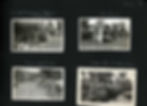
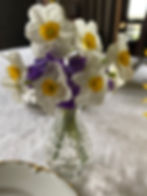
This leads to the question of exactly how blooms of varying scale should be arranged. Quite possibly, Mrs. Boyd had a specific centerpiece or epergne in mind – something that would provide separate basins for the two types of flowers. In the end, we cheated and ran into the yard and grabbed some violets from the mouths of attaching rabbits. Stuck them into a vase with some mini daffodils of an unknown variety and returned to making mayonnaise.
The Recipe: Mrs. George H. Boyd’s Tomato and Celery Salad
“Wanted – A cook and waitress; must be experienced. Apply Mrs. George H. Boyd, 1617 S. Washington.”
-The Saginaw Evening News, June 10, 1907

Tomato and Celery Salad – From: Twelve Menus: A Cook Book, published by The Young Woman’s Auxiliary to The Woman’s Hospital Association, Saginaw, Michigan, 1900.
Select medium sized, round firm tomatoes. Scald to remove the skins and scoop out the center. Set them away in a cold place until thoroughly chilled. Take the tender inside stalks of celery; wash in ice cold water, dry carefully in a cloth and cut in pieces about one-third of an inch long To every pint of these allow a half pint of Mayonnaise dressing. When ready to use the salad, toss the celery in the Mayonnaise, fill the tomatoes with the mixture and serve on lettuce leaves. Crackers spread with Neuchatel or Philadelphia cream cheese are a nice accompaniment to this salad.
Mayonnaise Dressing:
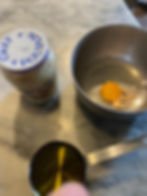
Put into an ice cold bowl the yolks of two eggs, half a teaspoonful of salt, half a teaspoonful of mustard and a dash of cayenne. Work these well together (using a Dover egg beater, or one of the new Mayonnaise mixers now in the market); then add, drop by drop, a pint or more of olive oil. You must stir rapidly and steadily while adding the oil. After adding one gill [4 fluid ounces] of oil alternate occasionally with a few drops of lemon juice or vinegar. More or less oil may be added, according to the quantity of dressing wanted. With care a quart bottle of oil may be stirred into the yolks of two eggs. If it gets too thick add a teaspoon or more of vinegar until a proper consistency. In warm weather, put the dish in which you make the Mayonnaise in a pan of ice water; the oil and eggs should also be cold.
Notes – and there are many of them:
Although written in a narrative form, we found the recipe straightforward, precise, and easy to follow. However, we do have some thoughts to share, before you prepare your own interpretation of Mrs. George H. Boyd’s Tomato and Celery salad:
Presentation: This is a recipe about presentation: While taste needs to be considered, appearance is more important. We believe the test kitchen sample is acceptable, but far from perfect. Your guests are to be surprised and charmed – maybe even a little in awe – by what is placed before them.
Peeling the Tomatoes: Although our test kitchen would not normally peel tomatoes before stuffing them, in this recipe they look great, and the texture of the soft, skinless tomatoes contrasts beautifully with the celery salad. It needs to be served cold.
Quantity: This part of the recipe is imprecise. The recipe calls for 1 part of dressing to 2 parts of celery. We made a half batch of the dressing – about one cup and combined it with two cups of celery. We had more than enough filling for 3 - 4 tomatoes.
The Homemade Mayonnaise: Homemade mayonnaise contains raw egg; the FDA does not recommend consuming it. However, the test kitchen staff tempted fate and tried making Mrs. Boyd’s recipe. (A Dover eggbeater is a rotary eggbeater. Dover was a manufacturer. Her alternate suggestion, “or one of the new mayonnaise mixers,” was a device that combined a mixer with an oil dispenser. They no longer seem to be readily available. This is a 123-year-old recipe).
Making mayonnaise can present challenges. In Mastering the Art of French Cooking, Julia Child proclaims: “you should be able to make it by hand as part of your general mastery of the egg yolk. It is certainly far from difficult once you understand the process, and after you have done it a few times you should easily and confidently be able to whip together a quart of sauce in less than 10 minutes.” Although her instructions differ from Julia Child’s, Mrs. Boyd’s recipe does work. (The test kitchen staff had misplaced its rotary mixer. Although tempted to use a blender or electric mixer, he was reminded of Mrs. Child’s admonishment about mayonnaise made in a blender: “no culinary skill whatsoever enters into its preparation.” A whisk was used.
The recipe calls for olive oil. Mayonnaise made with olive oil has a distinctive taste. Select one carefully. The test kitchen staff did not use enough care.
You can easily substitute prepared mayonnaise. However, add mustard about, ¼ tsp per cup.
Yes, this recipe is worth the effort. It doesn’t look – or taste – anything like the stuffed tomatoes that were served at lunch counters.
,


